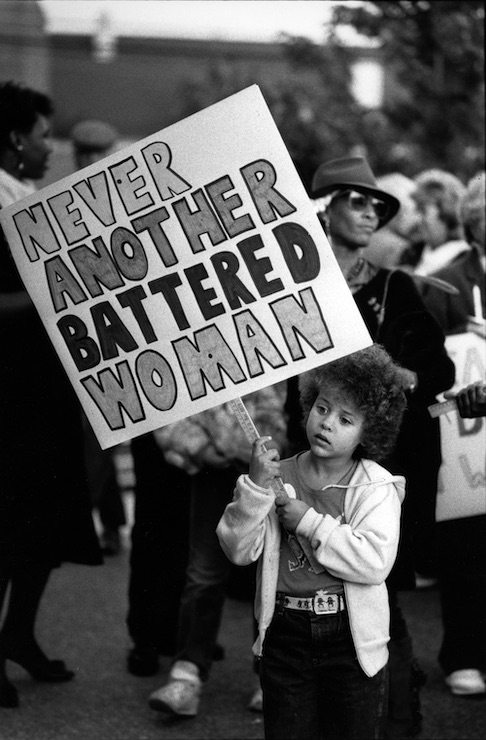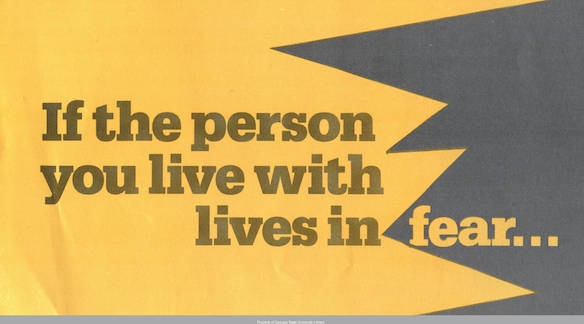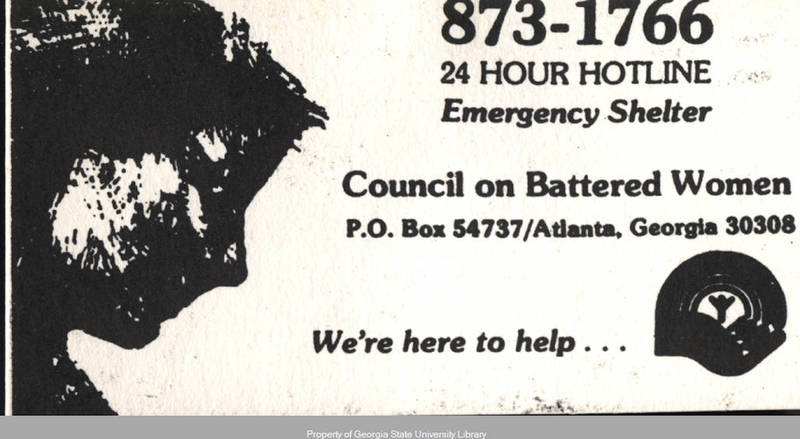Battered Women
The Council on Battered Women was Atlanta’s first organization founded to assist women who were victims of domestic abuse. Originally based at the YWCA, the Council began its life in 1975 as a small task force, with Susan May at the helm. May worked for the Council for four years, from 1978-1984, and during that time, the task force became a broadly-based community organization with a comprehensive program that included a crisis line, children’s program, and education services.
Over time, a number of other local organizations developed to assist victims and fight to end abuse. GSU’s Special Collections houses the records of a number of those organizations, including those of the Georgia Advocates for Battered Women and Children, the Georgia Commission on Family Violence, the Georgia Coalition Against Domestic Violence, Men Stopping Violence, and the Women’s Resource Center to End Domestic Violence.

Exerpt From Susan May Oral History, 17 May 2007
Susan May [Interviewee]: In the summer of ’75, Ms. Magazine came out with the cover issue on battered women. Del Martin was one of the writers. Del is a prominent, celebrated, journalist from San Francisco and was on the NOW, National NOW group that was talking about rape. [Del] wrote the book, Battered Wives and was prominent as a resource in the Ms. Magazine article. Everybody was starting to get this little by little.
I started a task force at the YW on battered women. Called everybody around – the police — you name it. and started meeting. We started doing more advertising to let people know that battered women could call the YWCA and get help. We put out our number and said you can come in and talk to us, that a counselor would be available on a certain night. Well we were just not quite getting it, that women couldn’t get away.
Mary Jo Duncanson [Interviewer]: At night or sometimes day?
SM: Right. And so it was phone counseling turned out to be what women wanted. I remember we advertised the existence of the task force in Creative Loafing.
MJD: Because it was cheap advertising.
SM: Free. There didn’t used to be pages of support groups because there weren’t any. So our little notice got attention. Things built and we realized we had to do something about shelter.

We started by providing shelter to women with arrangements with hotels or motels when they had extra space. That didn’t really work out. Because the support staff wasn’t there to help them. And the first time someone got a big telephone bill with long distance calls that ended that relationship with the hotel. But I know that, at that point, there were grants to help non-profits get employees. It was a work program. We applied for such a grant and we got a grant for everybody but a director. We called in elected officials. John Sweet, I remember and Esther Lefevre And later, Cathey Steinberg. We had meetings with people to figure out how could we get the money. Somebody took me down to United Way and introduced me to the grant writer there to show me how to better make a proposal to United Way. We just did everything we could.
We formed a non-profit finally, and broke off from being a task force to being our own non-profit because the YWCA said, ‘we’d rather have you do that than’ – we were getting lots of press. We were being asked to be on TV all the time. Susan Hampson was our first President, I believe. Then she moved away. Eventually I left my job at the YWCA so I could do this full time as a volunteer, and I was President of the Board.
I was President of the Board when the first director left after about a year. And by this time, we had CETA employees. That’s right – C-E-T-A, Comprehensive Employment Training Act, I think. We had CETA employees and finally, a grant from – that was from City of Atlanta, and then got a grant from DeKalb for the Director. I was President of the Board, but when she left, I became Director. We grew the organization and for four years I was the Director, from’78 to ’82.
During that time we grew, we had a couple of phone lines and as soon as we added a phone line, our calls would double. I don’t have the numbers in my head now, but I know, we’d get 150 calls a month then we’d add a phone line and we’d get 300 calls a month. We advertized on MARTA. They had what they called the “Rider’s Digest”, which were blurbs on buses and we’d advertize there, put our number up.

MJD: What kind of message?
SM: One campaign was, Love Doesn’t Have to Hurt. This is the number to call. I think it was an artist at the Atlanta Constitution who gave us that design, if I’m not mistaken.
We became a United Way agency. That is something I’m very, very proud of.
The one [thing] I’m proudest of is the paper bag of change that was put on the receptionist’s desk at the YW one day with the woman saying, “I drove 60 miles from a trailer park where I live to leave you this money. I wish you’d been there for me ten years ago. Thank you for what you’re doing.” Every single day, when I opened up the mail, I was reinspired. With the courage that the women who came to us showed, it was very inspiring.

